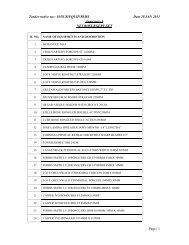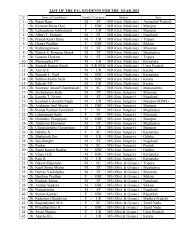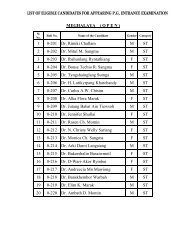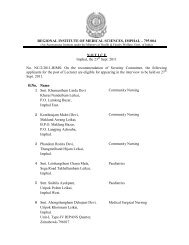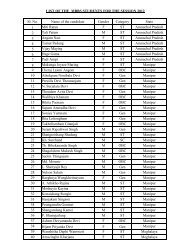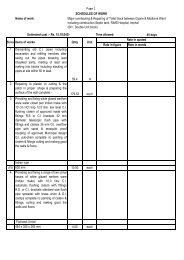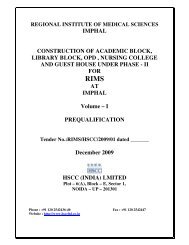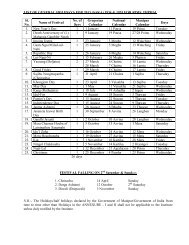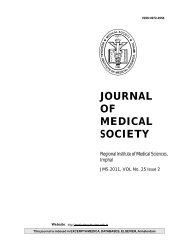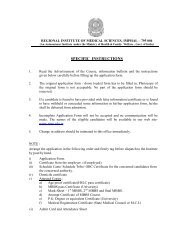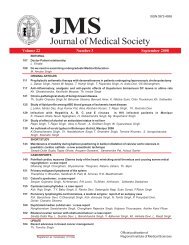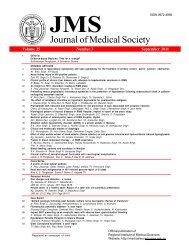Evidence-based Medicine: Time for a change? - Journal of Medical ...
Evidence-based Medicine: Time for a change? - Journal of Medical ...
Evidence-based Medicine: Time for a change? - Journal of Medical ...
Create successful ePaper yourself
Turn your PDF publications into a flip-book with our unique Google optimized e-Paper software.
ORIGINAL ARTICLE<br />
Materials and Methods: The study was<br />
carried out in 132 patients <strong>of</strong> CLD with or<br />
without HCC attending <strong>Medicine</strong> OPD in<br />
collaboration with Departments <strong>of</strong><br />
Radiotherapy and Radiodiagnosis, Regional<br />
Institute <strong>of</strong> <strong>Medical</strong> Sciences, Imphal during<br />
September 2008 to August 2010. It is a cross<br />
sectional study. Patients <strong>of</strong> known underlying<br />
malignancy, un-cooperative and unwilling<br />
subjects were excluded.<br />
In<strong>for</strong>med written consent was taken <strong>for</strong> each<br />
case. Detail clinical examination was carried<br />
out <strong>for</strong> each case. Routine investigations<br />
including complete haemogram, urine routine<br />
examination, kidney function test, liver function<br />
test, prothrombin time, random blood sugar,<br />
hepatitis B surface antigen (HBsAg),<br />
HBeAntigen and HCV antibody were done.<br />
HBV and HCV were confirmed by PCR at<br />
Roche Lab, Mumbai. Computed Tomography<br />
(CT) or Magnetic resonance Imaging (MRI)<br />
was done when USG report and serum AFP<br />
level are suggestive <strong>of</strong> HCC. Ultrasound/CT<br />
guided aspiration cytology was done <strong>for</strong><br />
confirmation <strong>of</strong> HCC.<br />
RESULTS AND OBSERVATIONS<br />
A total <strong>of</strong> 132 CLD were enrolled in the study,<br />
out <strong>of</strong> which 20 (15.16%) have HCC and 112<br />
(84.84%) were without HCC (p = 0.24). Of the<br />
112 CLD without HCC 83 (74.1%) were males<br />
and 29(25.9%) were females; <strong>of</strong> the 20<br />
subjects with HCC, 17 (85%) were males and<br />
3(15%) females (p = 0.43) as shown<br />
in Table 1.<br />
Table1.Pr<strong>of</strong>ile <strong>of</strong> chronic liver disease<br />
Pr<strong>of</strong>ile Male Female Total<br />
(N=100) (N=32) (N=132)<br />
CLD without HCC 83(83%) 29 (90.62%) 112 (84.84%)<br />
CLD with HCC 17(17%) 3 (9.38%) 20 (15.16%)<br />
The age-wise distribution <strong>of</strong> CLD with and<br />
without HCC is shown in table 2 and was<br />
found to be maximum in the age group 45-54<br />
years. The ages <strong>of</strong> the 20 HCC (15.15%) were<br />
all above 35 years. The maximum cases were<br />
from Imphal west which is also most thickly<br />
populated.<br />
Table 2. Age distribution:<br />
Age Group CLD without HCC CLD with HCC Total CLD<br />
64 yrs 7 (6.25%) 5 (25%) 12<br />
Total 112 (100%) 20 (100%) 132<br />
Of the 132 chronic liver disease subjects,<br />
69(52 presented with abdominal distension,<br />
49 with fever and 43 with jaundice. 21 had<br />
generalised weakness, 12 pain abdomen, 10<br />
upper GI bleeding, 4 hepatic encephalopathy<br />
and 2 with pulmonary tuberculosis. 18 had<br />
palpable hepatomegaly.<br />
The associated risk factors among the 132<br />
CLD were alcoholism (67 cases ie 50.75%),<br />
HCV (61 cases ie 46.21%) and HBV (11 ie<br />
8.33%). Twenty-six <strong>of</strong> the 67 chronic ALD were<br />
associated with HIV, chronic HCV, chronic<br />
HBV or combination <strong>of</strong> these. Of the 61 chronic<br />
HCV, 37(60.65%) were HCV mono-infection<br />
and the other 24 (39.35%) chronic HCV were<br />
associated with other risk factors like ALD (7<br />
cases), HIV (13 cases), HBV (3 cases) and<br />
HIV-ALD (1case).<br />
There were 20 cases <strong>of</strong> HCC (15.15%)<br />
amongst the 132 CLD cases. 9 <strong>of</strong> 61(14.75%)<br />
Graph showing risk factors <strong>of</strong> chronic liver<br />
disease and HCC<br />
chronic HCV and 3 <strong>of</strong> 11 (27.27%) chronic<br />
HBV were found to have HCC. 9 HCV<br />
associated HCC were associated with risk<br />
16 JMS * JMS Vol 25 * Vol * No. 25 3 * No. * September, 1 * June, 2010 2011



